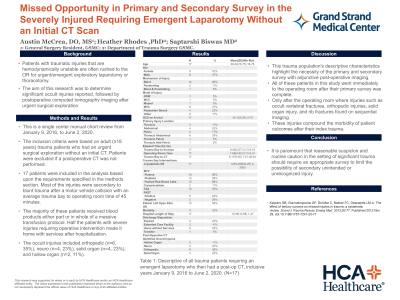Trauma
Category: Quickshot Oral Session 24
Quickshot Oral : Quickshot Oral Session 24
MISSED OPPORTUNITY IN PRIMARY AND SECONDARY SURVEY IN THE SEVERELY INJURED REQUIRING EMERGENT LAPAROTOMY WITHOUT AN INITIAL CT SCAN
Tuesday, February 14, 2023
7:00am - 8:00am East Coast USA Time

- AM
Austin O. McCrea, DO (he/him/his)
Resident
Grand Strand Medical Center, United States - SB
Saptarshi Biswas, MD FACS
Attending, United States
Presenter(s)
Principal Contact(s)
Objectives: Patients with traumatic injuries that are hemodynamically unstable are often rushed to the OR for urgent/emergent exploratory laparotomy or thoracotomy. The aim of this research was to determine significant occult injuries reported, followed by postoperative computed tomography imaging after urgent surgical exploration.
Methods: This is a single center manual chart review from January 9, 2016, to June 2, 2020. The inclusion criteria were based on adult (≥18 years) trauma patients who had an urgent surgical exploration without an initial CT. Patients were excluded if a postoperative CT was not performed.
Results: 17 patients
were included in the analysis based upon the requirements specified in the methods section.
Most of the injuries were secondary to blunt trauma after a motor vehicle collision with an average trauma bay to operating room time of 45 minutes. The majority of these patients received blood products either part or in whole of a massive transfusion protocol. Moreover, half the patients with severe injuries requiring operative intervention made it home with services after hospitalization. The occult injuries included orthopedic (n=6, 35%), neuro (n=4, 23%), solid organ (n=4, 23%), and hollow organ (n=2, 11%).
Conclusion: This trauma population's descriptive characteristics highlight the necessity of the primary and secondary survey with adjunctive post-operative imaging. All of these patients in this study went immediately to the operating room after their primary survey was complete. Only after the operating room where injuries such as occult vertebral fractures, orthopedic injuries, solid organ injury, and rib fractures found on sequential imaging. These injuries compound the morbidity of patient outcomes after their index trauma. Therefore, it is paramount that
reasonable suspicion and routine caution in the setting of significant trauma should require an appropriate survey to limit the possibility of secondary unintended or unrecognized injury.
Methods: This is a single center manual chart review from January 9, 2016, to June 2, 2020. The inclusion criteria were based on adult (≥18 years) trauma patients who had an urgent surgical exploration without an initial CT. Patients were excluded if a postoperative CT was not performed.
Results: 17 patients
were included in the analysis based upon the requirements specified in the methods section.
Most of the injuries were secondary to blunt trauma after a motor vehicle collision with an average trauma bay to operating room time of 45 minutes. The majority of these patients received blood products either part or in whole of a massive transfusion protocol. Moreover, half the patients with severe injuries requiring operative intervention made it home with services after hospitalization. The occult injuries included orthopedic (n=6, 35%), neuro (n=4, 23%), solid organ (n=4, 23%), and hollow organ (n=2, 11%).
Conclusion: This trauma population's descriptive characteristics highlight the necessity of the primary and secondary survey with adjunctive post-operative imaging. All of these patients in this study went immediately to the operating room after their primary survey was complete. Only after the operating room where injuries such as occult vertebral fractures, orthopedic injuries, solid organ injury, and rib fractures found on sequential imaging. These injuries compound the morbidity of patient outcomes after their index trauma. Therefore, it is paramount that
reasonable suspicion and routine caution in the setting of significant trauma should require an appropriate survey to limit the possibility of secondary unintended or unrecognized injury.

